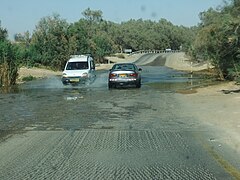River ford

Vehicles crossing a modern ford over a creek
|
|
| Ancestor | None |
|---|---|
| Related | None, but akin to causeway |
| Descendant | None, but akin to step-stone bridge |
| Carries | Traffic |
| Span range | Short |
| Material | Usually none (natural, preexisting), but sometimes supplemented with concrete or asphalt for vehicles. |
| Movable | No |
| Design effort | None or low |
| Falsework required | No |
A ford is a shallow place with good footing where a river or stream may be crossed by wading, or inside a vehicle getting its wheels wet. A ford is mostly a natural phenomenon, in contrast to a low water crossing, which is an artificial bridge that allows crossing a river or stream when water is low.
A ford is a much cheaper form of river crossing than a bridge, but it may become impassable after heavy rain or during flood conditions. A ford is therefore normally only suitable for very minor roads (and for paths intended for walkers and horse riders etc.). Most modern fords are usually shallow enough to be crossed by cars and other wheeled or tracked vehicles (a process known as "fording").
In New Zealand, however, fords are a normal part of major roads, including, until 2010, along State Highway 1 on the South Island's east coast. As most inter-city domestic passengers travel by air and as much cargo goes by sea, long distance road traffic is low and fords are thus a practical necessity for crossing seasonal rivers. In dry weather, drivers become aware of a ford by crunching across outwash detritus on the roadway. A Bailey bridge may be built off the main line of the road to carry emergency traffic during high water.
At places where the water is shallow enough, but the material on the riverbed will not support heavy vehicles, fords are sometimes improved by building a submerged concrete floor. In such cases a curb (kerb) is often placed on the downstream side to prevent vehicles slipping off, as growth of algae will often make the slab very slippery. Fords may be also equipped with a post indicating the water depth, so that users may know if the water is too deep to attempt to cross. Some have an adjacent footbridge so that pedestrians may cross without getting their feet wet.
A road running below the water level of a stream or river is often known as a "watersplash". It is a common name for a ford or stretch of wet road in some areas, and sometimes also used to describe tidal crossings. They have become a common feature in rallying courses. There are enthusiasts who seek out and drive through these water features, recording details (such as wave created, position and access) on dedicated websites.
...
Wikipedia
